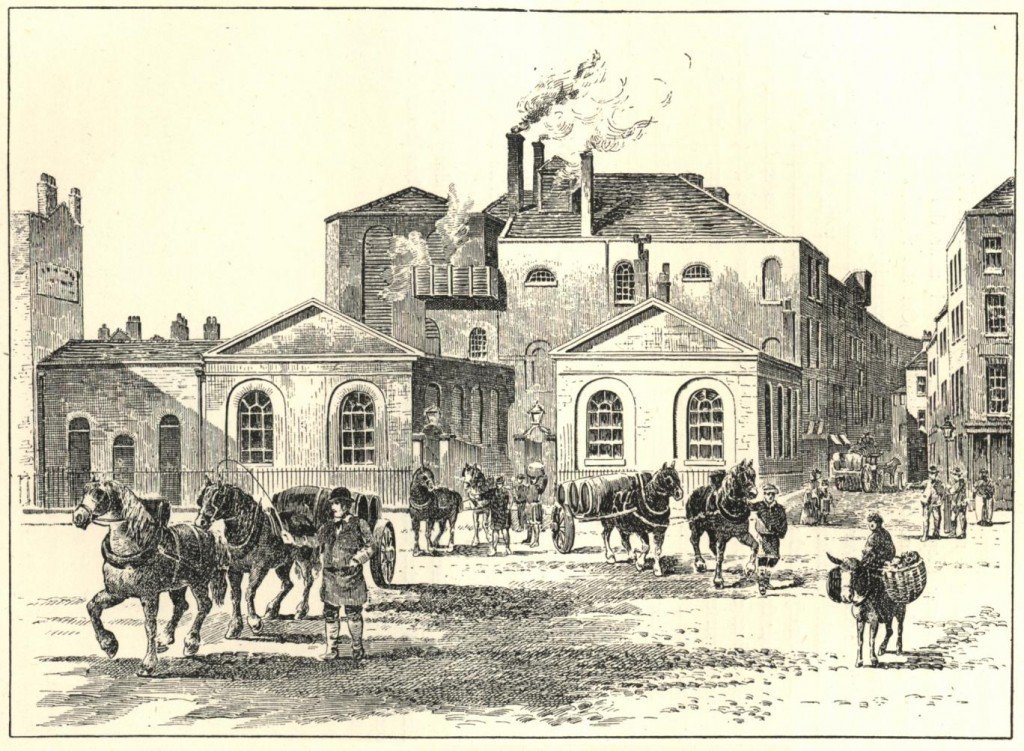by Tom Clavin
Two hundred and nine years ago, an event took place that was both bizarre and tragic and I cannot resist writing about it—the London Beer Flood.

In the early 19th century, the Meux Brewery was one of the two largest in London, along with Whitbread. In 1809, Sir Henry Meux had constructed a wooden vessel 22 feet tall and capable of holding 18,000 imperial barrels. Eighty long tons of iron hoops were used to strengthen the vat. Meux brewed only porter, a dark beer that was first brewed in London and was the most popular alcoholic drink in the capital. Meux & Co brewed 102,493 imperial barrels in the 12 months leading up to July 1812. Porter was left in the large vessels to mature for several months, or up to a year for the best quality versions.
At the rear of the brewery ran New Street, a small cul-de-sac that joined on to Dyott Street within the St. Giles rookery. The rookery, which covered an area of eight acres, was a perpetually decaying slum seemingly always on the verge of social and economic collapse. The preacher Thomas Beames described the St. Giles rookery less charitably, as “a rendezvous of the scum of society.” Supposedly, the area had been the inspiration for William Hogarth’s 1751 print Gin Lane.
At around 4:30 in the afternoon of October 17, 1814, George Crick, Meux’s storehouse clerk, saw that one of the 700-pound iron bands around a vat had slipped. The 22-foot-tall vessel was filled to within four inches of the top with 3,555 imperial barrels of 10-month-old porter. As the bands slipped off the vats two or three times a year, Crick was unconcerned. He told his supervisor about the problem but was told that no harm whatever would ensue. Crick was told to write a note to Mr. Young, one of the partners of the brewery, to have it fixed later.
Yes, you know where this is going . . .
An hour after the hoop fell off, Crick was standing on a platform 30 feet from the vat, holding the note to Mr. Young, when the vessel, with no warning, burst. The force of the liquid’s release knocked the stopcock from a neighboring vat, which also began discharging its contents. Several hogsheads of porter were destroyed, and their contents added to the flood. As much as 323,000 imperial gallons were released. The force of the liquid destroyed the rear wall of the brewery that was 25 feet high and two and a half bricks thick. Some of the bricks from the back wall were knocked upwards and fell onto the roofs of the houses in the nearby Great Russell Street.
A wave of porter some 15 feet high swept into New Street, where it destroyed two houses and badly damaged two others. In one of the houses a four-year-old girl, Hannah Bamfield, was having tea with her mother and another child. The wave of beer swept the mother and the second child into the street; Hannah was killed. In the second destroyed house, a wake was being held by an Irish family for a two-year-old boy. As if that was not enough death, when the tsunami of porter struck the house, Anne Saville, the boy’s mother, and four other mourners—Mary Mulvey and her three-year-old son, Elizabeth Smith, and Catherine Butler—were killed.
Eleanor Cooper, a 14-year-old servant of the publican of the Tavistock Arms in Great Russell Street, died when she was buried under the brewery’s collapsed wall while washing pots in the pub’s yard. Another child, Sarah Bates, was found dead in another house on New Street. The land around the building was low-lying and flat. With insufficient drainage, the beer flowed into cellars, many of which were inhabited, and people were forced to climb on furniture to avoid drowning.
All those in the brewery survived, although three workmen had to be rescued from the rubble. The superintendent and one of the workers were taken to Middlesex Hospital, along with three others. Stories later arose of hundreds of people collecting the beer, mass drunkenness, and a death from alcohol poisoning a few days later. However, newspapers of the time made no reference to the revelry.
According to one account, the area surrounding the rear of the brewery showed a “scene of desolation [that] presents a most awful and terrific appearance, equal to that which fire or earthquake may be supposed to occasion.” Watchmen at the brewery charged people to view the remains of the destroyed beer vats and several hundred spectators came to view the scene. The mourners killed in the cellar were given their own wake at The Ship public house on Bainbridge Street. The other bodies were laid out in a nearby yard by their families; the public came to see them and donated money for their funerals. Collections were taken up more widely for the families.
Because the coroner’s inquest reached a verdict of an “act of God,” Meux & Co did not have to pay compensation. Nevertheless, the disaster—the lost porter, the damage to the buildings, and the replacement of the vat—cost the company £23,000. After a private petition to Parliament, it recovered about £7,250 from HM Excise, saving them from bankruptcy. The brewery went back into business soon afterward but closed in 1921 when Meux moved its production operations elsewhere. The brewery was demolished the following year and the Dominion Theatre was later built on the site.
As a result of the so-dubbed London Beer Flood, large wooden tanks were phased out across the brewing industry and replaced with lined concrete vessels.
Originally published on Tom Clavin’s The Overlook.

Tom Clavin is a #1 New York Times bestselling author and has worked as a newspaper editor, magazine writer, TV and radio commentator, and a reporter for The New York Times. He has received awards from the Society of Professional Journalists, Marine Corps Heritage Foundation, and National Newspaper Association. His books include the bestselling Frontier Lawmen trilogy—Wild Bill, Dodge City, and Tombstone—and Blood and Treasure with Bob Drury. He lives in Sag Harbor, NY.
